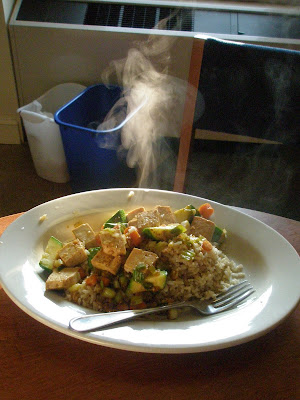I wrote this paper for my Prose Style class a few weeks ago. It seemed appropriate for the blog, so here it is -- edited to be internet-friendly.
But before that, let me add that while this gives a brief summary of the Toledo internship, Dirt Cheap Delicious has a long and tasty future ahead of it. Check back this week for another update, maybe with photos.
On the Potential of Food Therapy to Solve a Multitude of Woes
From the wild and wonderful world of psychiatry, most proposed therapies sound ridiculous. Living in the wake of Freud and Jung, we face a huge variety of approaches to healing the human psyche, including music therapy, primal yell therapy, body talk system and dyadic development psychotherapy. According to a friend of mine, a new form of therapy is emerging: food therapy. It’s simple: A therapist teaches a patient how to follow a recipe to make a dish, walking her through the steps in her own home. Then the patient makes the recipe without as much help. Eventually, she makes the recipe all by herself. Apparently this helps patients who suffer from autism, schizophrenia, hypertension, anorexia, and a variety of other mental disorders.
At first, this sounded pretty hokey to me. How on earth would teaching a paranoid schizophrenic how to make spaghetti solve any of his mental problems? After considering the theory a bit more, though, I have become confident food therapy has promise. This is because last summer, my roommate and I underwent food therapy unintentionally.
We worked at a small weekly newspaper in Toledo, Ohio, known as the Glass City –– or, as I call it, the City of Lost Dreams. We worked long hours, ate peanut butter and jelly for lunch every day, and didn’t get paid much. The interview subjects –– including mayors, auto mechanics, Army Corps of Engineers public relations peons, and senile old people –– provided constant miscommunication, offense and stress.
And once a homeless man asked me if I was a call girl.
It was a stressful summer. Rewarding, challenging, and worthwhile, but stressful.
So, unintentionally, Mary and I engaged in food therapy. Every day when we got home from work, we would kick off our high heels and scamper to the kitchen, where we would chop, mash, stir, simmer, boil, taste, season, and bake until the stress evaporated with the steam.
But that’s not all. See, Mary and I slept on the floor next to each other, drove to work together, worked at neighboring desks, drove home from work together, ate dinner together, and went to bed at about the same time. After the first week, we knew everything there was to know about each other. The only thing left to talk about? Food.
We planned a weekly menu every Sunday night and updated it through the week. We discussed the value of organic produce. We organized grocery lists. We debated over our favorite kind of leafy greens, concluding that rainbow chard was the best. We had only one relationship-threatening fight, and it was over food: I thought Mary was far too slow to sample new foods, and I told her this bluntly and often. She, on the other hand, felt perfectly happy living in a world without hummus, Indian food, beans, and guacamole. At one point, voices were raised.
But we didn’t just talk about food; we let it take over our lives. We went to the farmers’ market twice a week. Once we drove 30 minutes to get antibiotic- and horomone-free eggs from a local farm. We perfected a tomato soup recipe (Mary would sneak into the kitchen after I’d gone to sleep and eat all the leftovers), questioned a neighbor about vegetables and gender roles, and kept a blog -- which you are reading -- about our exploits.
In that sense, food doesn’t seem particularly therapeutic if it makes you obsessive-compulsive. But it gave us a constant source of entertainment, a creative outlet, a topic for debate, and a productive way to vent our frustration. I discovered that at the end of a stressful day, nothing blows off steam like hacking up a carrot.
So we perfected the science of frittata, sauteed broccoli, enchiladas, and food therapy. We cooked ourselves to sanity. That’s why I have hope in this new method; if it worked for us, it can work for anyone.
And, to get you started, I leave you with “Betsy and Mary’s Original Recipe for Sauteed Broccoli of the Gods”
1. Pour about a tablespoon of canola or olive oil into a large frying pan. Let it heat for a bit and add some salt, a minced clove or two of garlic, and some freshly-ground black pepper.
2. Add a small handful of chopped green onion. Let it fry for a few minutes, until it starts to look a little darker.
3. Add a head of broccoli, chopped. Push the broccoli around and flip the pieces over so it cooks evenly.
4. With a spatula, push down on the broccoli so it gets a nice sear.
5. Once the edges of some of the broccoli pieces are a little blackened, turn off the heat and divide it among two or three plates. Eat it immediately. Go back for seconds.














